height BUICK REGAL 2011 Owner's Manual
[x] Cancel search | Manufacturer: BUICK, Model Year: 2011, Model line: REGAL, Model: BUICK REGAL 2011Pages: 368, PDF Size: 5.35 MB
Page 9 of 368
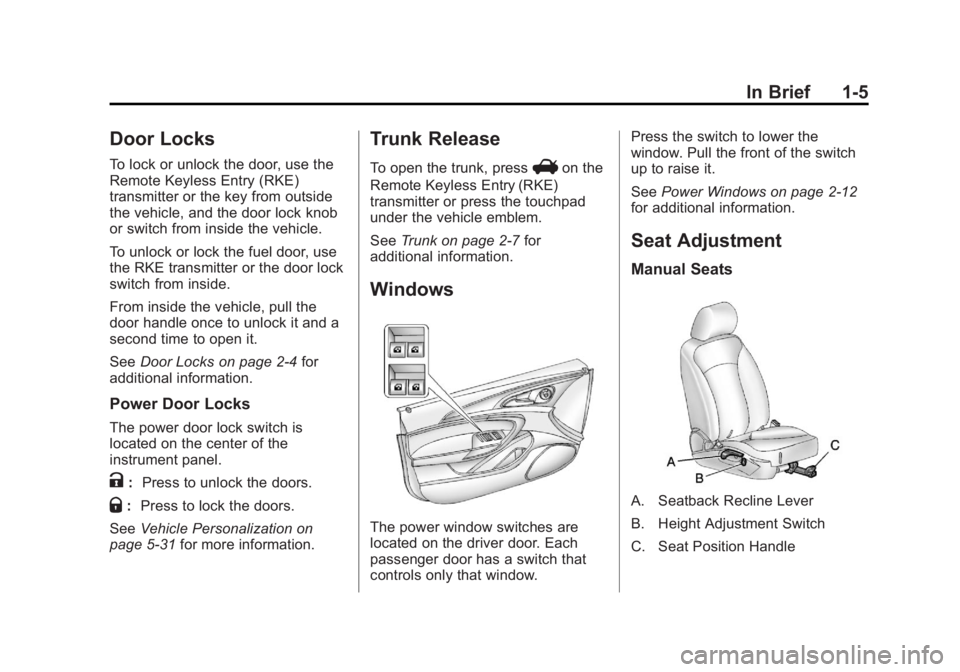
Black plate (5,1)Buick Regal Owner Manual - 2011
In Brief 1-5
Door Locks
To lock or unlock the door, use the
Remote Keyless Entry (RKE)
transmitter or the key from outside
the vehicle, and the door lock knob
or switch from inside the vehicle.
To unlock or lock the fuel door, use
the RKE transmitter or the door lock
switch from inside.
From inside the vehicle, pull the
door handle once to unlock it and a
second time to open it.
SeeDoor Locks on page 2‑4 for
additional information.
Power Door Locks
The power door lock switch is
located on the center of the
instrument panel.
K: Press to unlock the doors.
Q:Press to lock the doors.
See Vehicle Personalization on
page 5‑31 for more information.
Trunk Release
To open the trunk, pressVon the
Remote Keyless Entry (RKE)
transmitter or press the touchpad
under the vehicle emblem.
See Trunk on page 2‑7 for
additional information.
Windows
The power window switches are
located on the driver door. Each
passenger door has a switch that
controls only that window. Press the switch to lower the
window. Pull the front of the switch
up to raise it.
See
Power Windows on page 2‑12
for additional information.
Seat Adjustment
Manual Seats
A. Seatback Recline Lever
B. Height Adjustment Switch
C. Seat Position Handle
Page 10 of 368
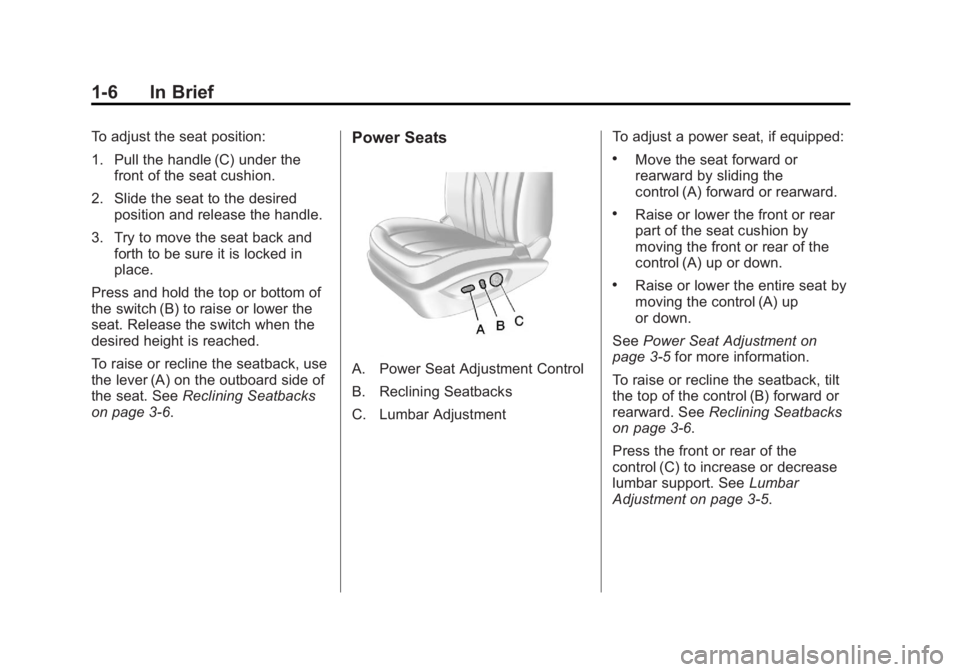
Black plate (6,1)Buick Regal Owner Manual - 2011
1-6 In Brief
To adjust the seat position:
1. Pull the handle (C) under thefront of the seat cushion.
2. Slide the seat to the desired position and release the handle.
3. Try to move the seat back and forth to be sure it is locked in
place.
Press and hold the top or bottom of
the switch (B) to raise or lower the
seat. Release the switch when the
desired height is reached.
To raise or recline the seatback, use
the lever (A) on the outboard side of
the seat. See Reclining Seatbacks
on page 3‑6.Power Seats
A. Power Seat Adjustment Control
B. Reclining Seatbacks
C. Lumbar Adjustment To adjust a power seat, if equipped:
.Move the seat forward or
rearward by sliding the
control (A) forward or rearward.
.Raise or lower the front or rear
part of the seat cushion by
moving the front or rear of the
control (A) up or down.
.Raise or lower the entire seat by
moving the control (A) up
or down.
See Power Seat Adjustment on
page 3‑5 for more information.
To raise or recline the seatback, tilt
the top of the control (B) forward or
rearward. See Reclining Seatbacks
on page 3‑6.
Press the front or rear of the
control (C) to increase or decrease
lumbar support. See Lumbar
Adjustment on page 3‑5.
Page 11 of 368
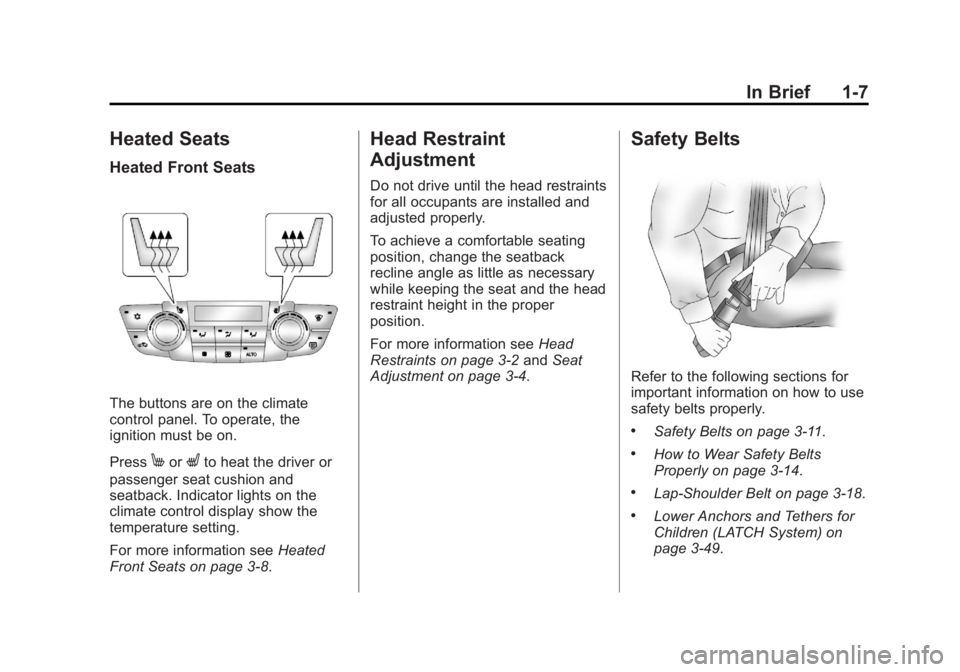
Black plate (7,1)Buick Regal Owner Manual - 2011
In Brief 1-7
Heated Seats
Heated Front Seats
The buttons are on the climate
control panel. To operate, the
ignition must be on.
Press
MorLto heat the driver or
passenger seat cushion and
seatback. Indicator lights on the
climate control display show the
temperature setting.
For more information see Heated
Front Seats on page 3‑8.
Head Restraint
Adjustment
Do not drive until the head restraints
for all occupants are installed and
adjusted properly.
To achieve a comfortable seating
position, change the seatback
recline angle as little as necessary
while keeping the seat and the head
restraint height in the proper
position.
For more information see Head
Restraints on page 3‑2 andSeat
Adjustment on page 3‑4.
Safety Belts
Refer to the following sections for
important information on how to use
safety belts properly.
.Safety Belts on page 3‑11.
.How to Wear Safety Belts
Properly on page 3‑14.
.Lap-Shoulder Belt on page 3‑18.
.Lower Anchors and Tethers for
Children (LATCH System) on
page 3‑49.
Page 44 of 368
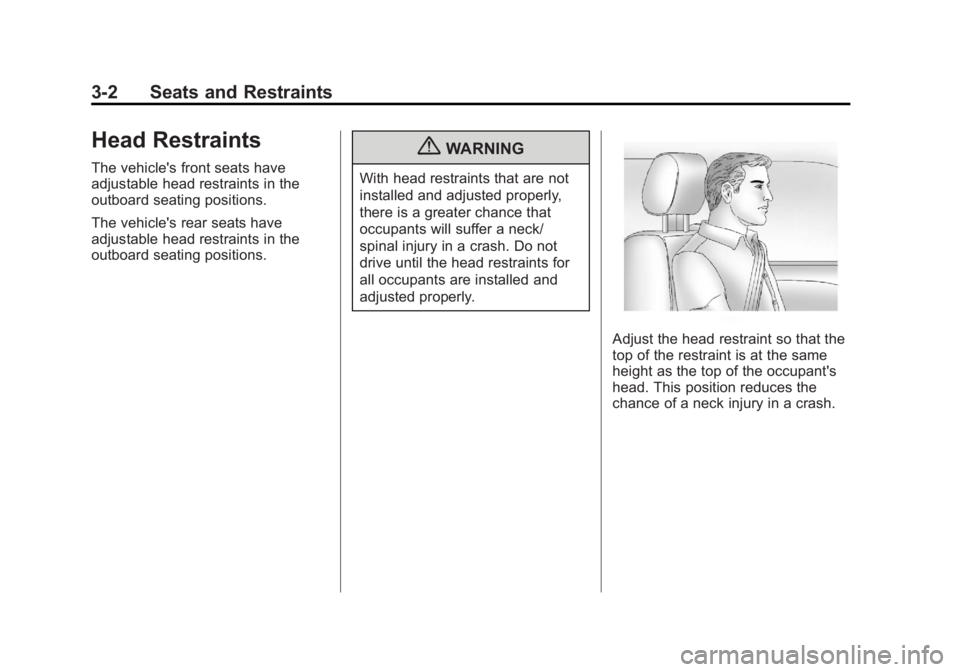
Black plate (2,1)Buick Regal Owner Manual - 2011
3-2 Seats and Restraints
Head Restraints
The vehicle's front seats have
adjustable head restraints in the
outboard seating positions.
The vehicle's rear seats have
adjustable head restraints in the
outboard seating positions.
{WARNING
With head restraints that are not
installed and adjusted properly,
there is a greater chance that
occupants will suffer a neck/
spinal injury in a crash. Do not
drive until the head restraints for
all occupants are installed and
adjusted properly.
Adjust the head restraint so that the
top of the restraint is at the same
height as the top of the occupant's
head. This position reduces the
chance of a neck injury in a crash.
Page 47 of 368
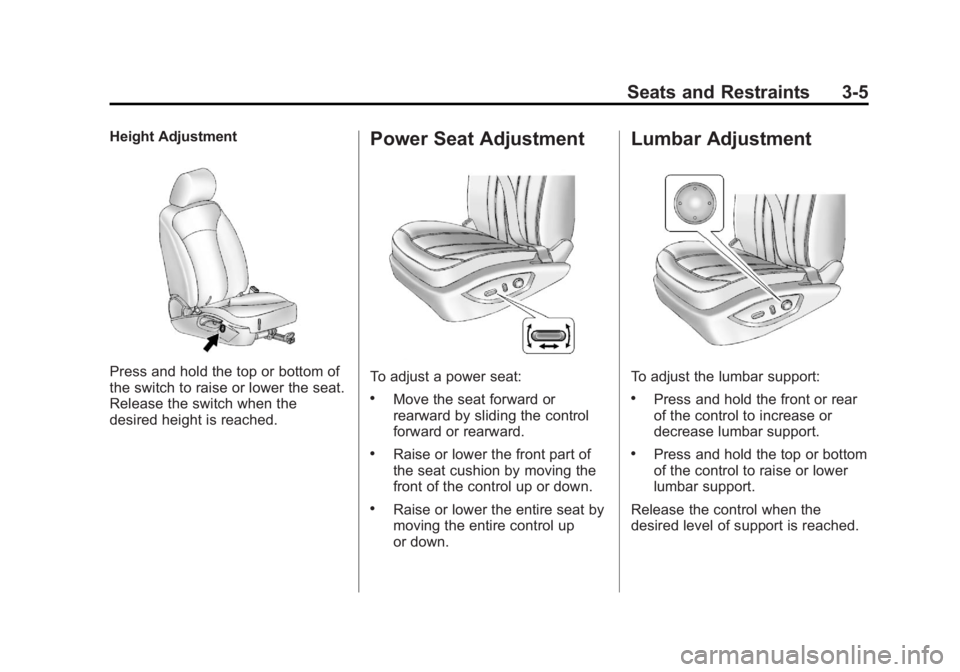
Black plate (5,1)Buick Regal Owner Manual - 2011
Seats and Restraints 3-5
Height Adjustment
Press and hold the top or bottom of
the switch to raise or lower the seat.
Release the switch when the
desired height is reached.
Power Seat Adjustment
To adjust a power seat:
.Move the seat forward or
rearward by sliding the control
forward or rearward.
.Raise or lower the front part of
the seat cushion by moving the
front of the control up or down.
.Raise or lower the entire seat by
moving the entire control up
or down.
Lumbar Adjustment
To adjust the lumbar support:
.Press and hold the front or rear
of the control to increase or
decrease lumbar support.
.Press and hold the top or bottom
of the control to raise or lower
lumbar support.
Release the control when the
desired level of support is reached.
Page 61 of 368
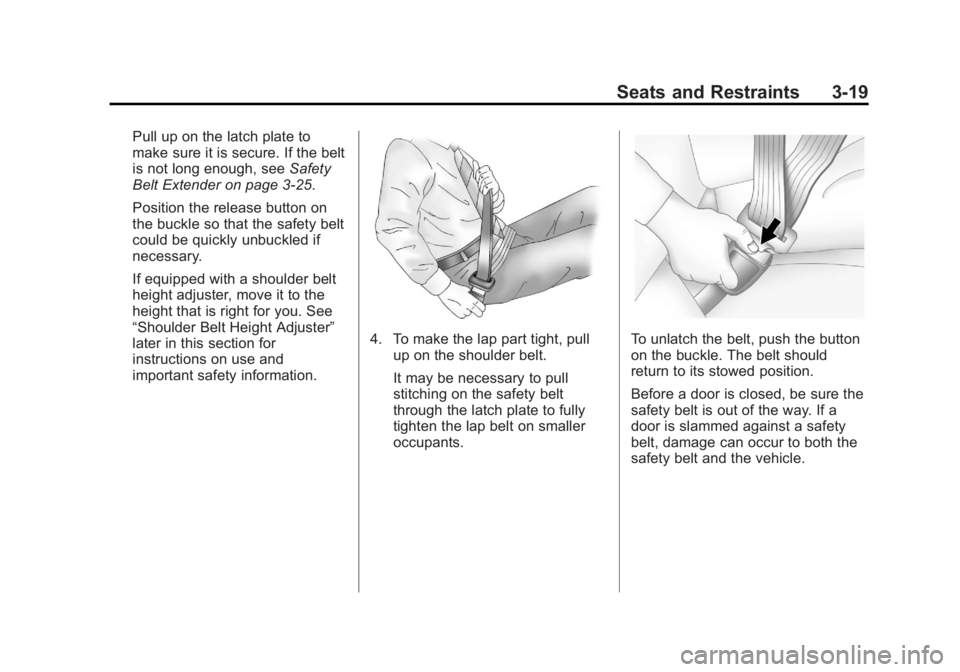
Black plate (19,1)Buick Regal Owner Manual - 2011
Seats and Restraints 3-19
Pull up on the latch plate to
make sure it is secure. If the belt
is not long enough, seeSafety
Belt Extender on page 3‑25.
Position the release button on
the buckle so that the safety belt
could be quickly unbuckled if
necessary.
If equipped with a shoulder belt
height adjuster, move it to the
height that is right for you. See
“Shoulder Belt Height Adjuster”
later in this section for
instructions on use and
important safety information.
4. To make the lap part tight, pull up on the shoulder belt.
It may be necessary to pull
stitching on the safety belt
through the latch plate to fully
tighten the lap belt on smaller
occupants.To unlatch the belt, push the button
on the buckle. The belt should
return to its stowed position.
Before a door is closed, be sure the
safety belt is out of the way. If a
door is slammed against a safety
belt, damage can occur to both the
safety belt and the vehicle.
Page 62 of 368
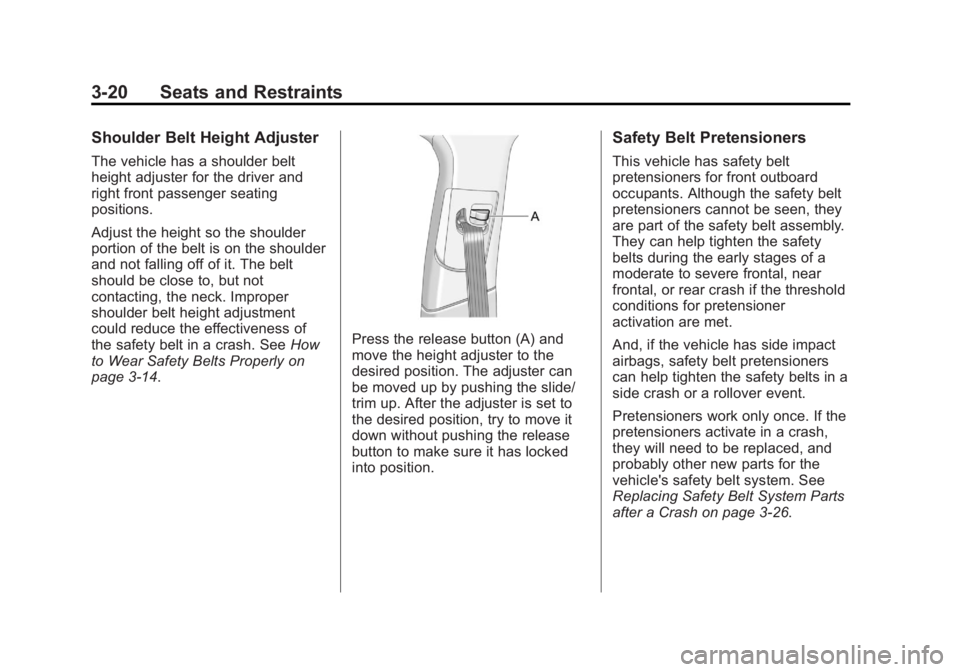
Black plate (20,1)Buick Regal Owner Manual - 2011
3-20 Seats and Restraints
Shoulder Belt Height Adjuster
The vehicle has a shoulder belt
height adjuster for the driver and
right front passenger seating
positions.
Adjust the height so the shoulder
portion of the belt is on the shoulder
and not falling off of it. The belt
should be close to, but not
contacting, the neck. Improper
shoulder belt height adjustment
could reduce the effectiveness of
the safety belt in a crash. SeeHow
to Wear Safety Belts Properly on
page 3‑14.
Press the release button (A) and
move the height adjuster to the
desired position. The adjuster can
be moved up by pushing the slide/
trim up. After the adjuster is set to
the desired position, try to move it
down without pushing the release
button to make sure it has locked
into position.
Safety Belt Pretensioners
This vehicle has safety belt
pretensioners for front outboard
occupants. Although the safety belt
pretensioners cannot be seen, they
are part of the safety belt assembly.
They can help tighten the safety
belts during the early stages of a
moderate to severe frontal, near
frontal, or rear crash if the threshold
conditions for pretensioner
activation are met.
And, if the vehicle has side impact
airbags, safety belt pretensioners
can help tighten the safety belts in a
side crash or a rollover event.
Pretensioners work only once. If the
pretensioners activate in a crash,
they will need to be replaced, and
probably other new parts for the
vehicle's safety belt system. See
Replacing Safety Belt System Parts
after a Crash on page 3‑26.
Page 80 of 368
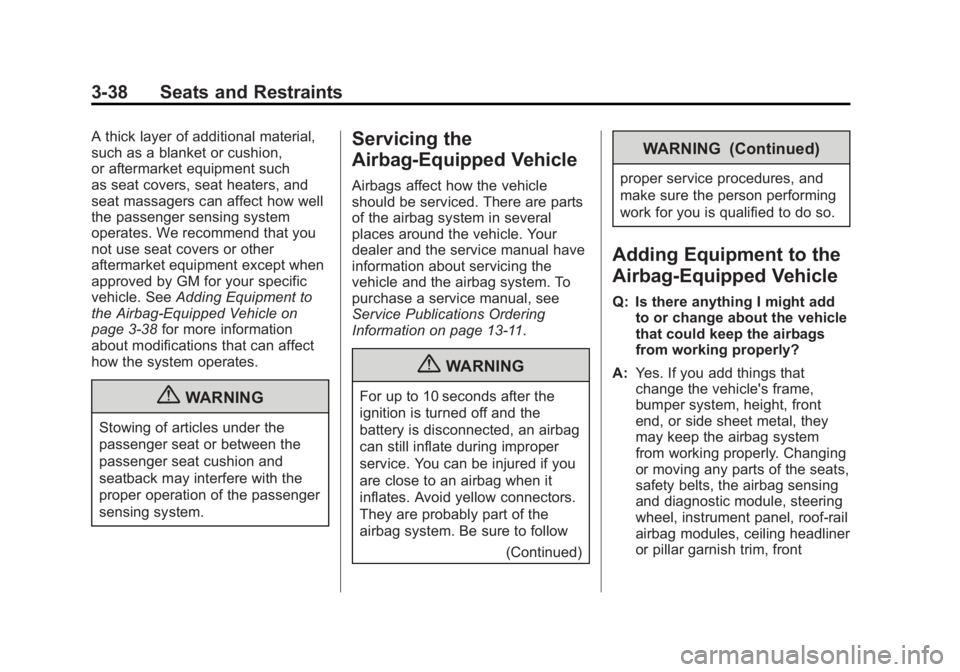
Black plate (38,1)Buick Regal Owner Manual - 2011
3-38 Seats and Restraints
A thick layer of additional material,
such as a blanket or cushion,
or aftermarket equipment such
as seat covers, seat heaters, and
seat massagers can affect how well
the passenger sensing system
operates. We recommend that you
not use seat covers or other
aftermarket equipment except when
approved by GM for your specific
vehicle. SeeAdding Equipment to
the Airbag-Equipped Vehicle on
page 3‑38 for more information
about modifications that can affect
how the system operates.
{WARNING
Stowing of articles under the
passenger seat or between the
passenger seat cushion and
seatback may interfere with the
proper operation of the passenger
sensing system.
Servicing the
Airbag-Equipped Vehicle
Airbags affect how the vehicle
should be serviced. There are parts
of the airbag system in several
places around the vehicle. Your
dealer and the service manual have
information about servicing the
vehicle and the airbag system. To
purchase a service manual, see
Service Publications Ordering
Information on page 13‑11.
{WARNING
For up to 10 seconds after the
ignition is turned off and the
battery is disconnected, an airbag
can still inflate during improper
service. You can be injured if you
are close to an airbag when it
inflates. Avoid yellow connectors.
They are probably part of the
airbag system. Be sure to follow
(Continued)
WARNING (Continued)
proper service procedures, and
make sure the person performing
work for you is qualified to do so.
Adding Equipment to the
Airbag-Equipped Vehicle
Q: Is there anything I might addto or change about the vehicle
that could keep the airbags
from working properly?
A: Yes. If you add things that
change the vehicle's frame,
bumper system, height, front
end, or side sheet metal, they
may keep the airbag system
from working properly. Changing
or moving any parts of the seats,
safety belts, the airbag sensing
and diagnostic module, steering
wheel, instrument panel, roof-rail
airbag modules, ceiling headliner
or pillar garnish trim, front
Page 83 of 368
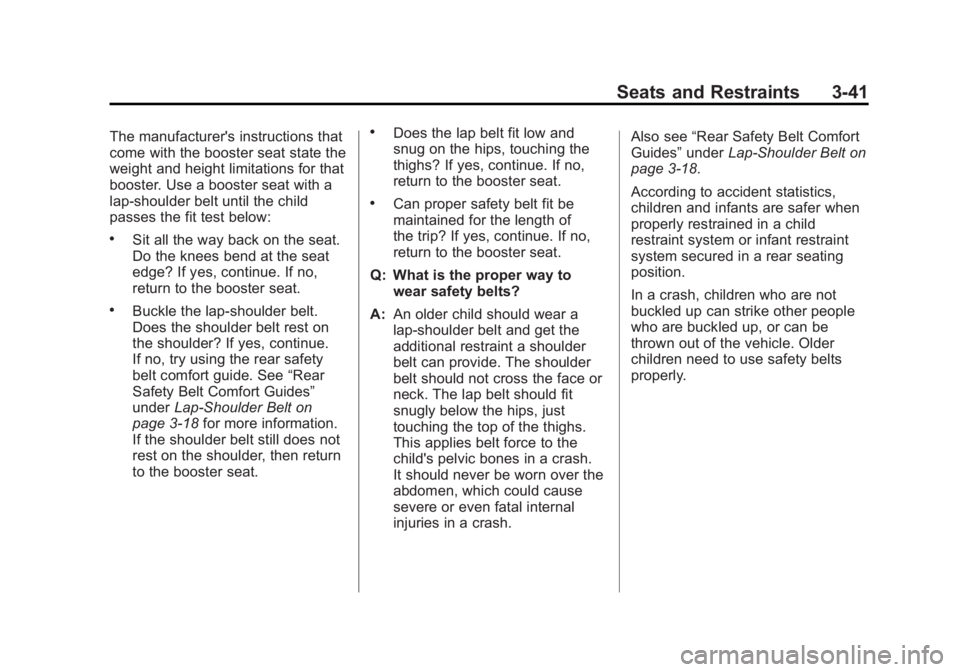
Black plate (41,1)Buick Regal Owner Manual - 2011
Seats and Restraints 3-41
The manufacturer's instructions that
come with the booster seat state the
weight and height limitations for that
booster. Use a booster seat with a
lap-shoulder belt until the child
passes the fit test below:
.Sit all the way back on the seat.
Do the knees bend at the seat
edge? If yes, continue. If no,
return to the booster seat.
.Buckle the lap-shoulder belt.
Does the shoulder belt rest on
the shoulder? If yes, continue.
If no, try using the rear safety
belt comfort guide. See“Rear
Safety Belt Comfort Guides”
under Lap-Shoulder Belt on
page 3‑18 for more information.
If the shoulder belt still does not
rest on the shoulder, then return
to the booster seat.
.Does the lap belt fit low and
snug on the hips, touching the
thighs? If yes, continue. If no,
return to the booster seat.
.Can proper safety belt fit be
maintained for the length of
the trip? If yes, continue. If no,
return to the booster seat.
Q: What is the proper way to wear safety belts?
A: An older child should wear a
lap-shoulder belt and get the
additional restraint a shoulder
belt can provide. The shoulder
belt should not cross the face or
neck. The lap belt should fit
snugly below the hips, just
touching the top of the thighs.
This applies belt force to the
child's pelvic bones in a crash.
It should never be worn over the
abdomen, which could cause
severe or even fatal internal
injuries in a crash. Also see
“Rear Safety Belt Comfort
Guides” underLap-Shoulder Belt on
page 3‑18.
According to accident statistics,
children and infants are safer when
properly restrained in a child
restraint system or infant restraint
system secured in a rear seating
position.
In a crash, children who are not
buckled up can strike other people
who are buckled up, or can be
thrown out of the vehicle. Older
children need to use safety belts
properly.
Page 86 of 368
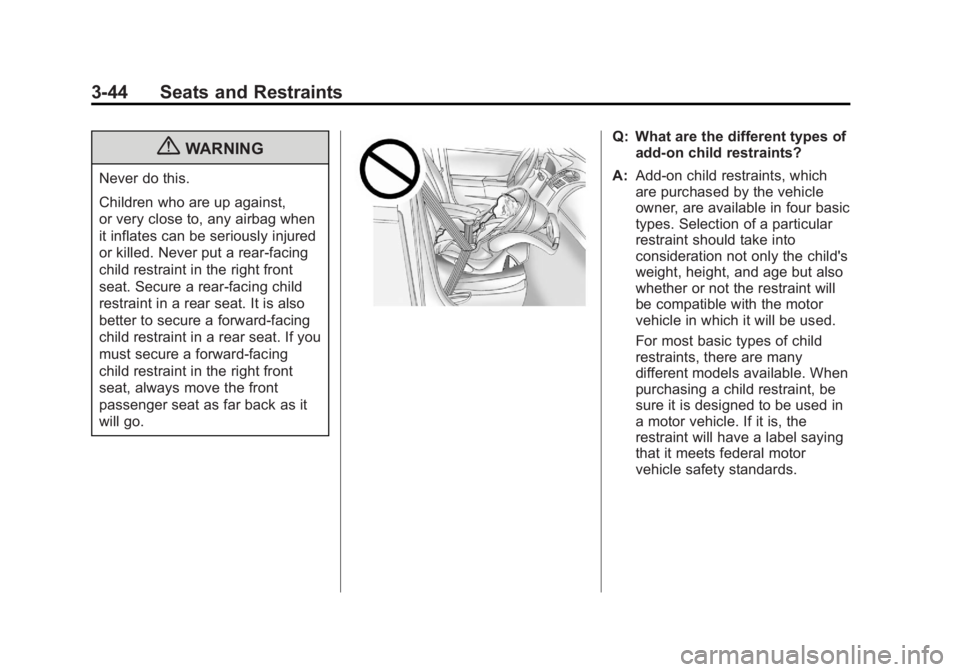
Black plate (44,1)Buick Regal Owner Manual - 2011
3-44 Seats and Restraints
{WARNING
Never do this.
Children who are up against,
or very close to, any airbag when
it inflates can be seriously injured
or killed. Never put a rear-facing
child restraint in the right front
seat. Secure a rear-facing child
restraint in a rear seat. It is also
better to secure a forward-facing
child restraint in a rear seat. If you
must secure a forward-facing
child restraint in the right front
seat, always move the front
passenger seat as far back as it
will go.
Q: What are the different types ofadd-on child restraints?
A: Add-on child restraints, which
are purchased by the vehicle
owner, are available in four basic
types. Selection of a particular
restraint should take into
consideration not only the child's
weight, height, and age but also
whether or not the restraint will
be compatible with the motor
vehicle in which it will be used.
For most basic types of child
restraints, there are many
different models available. When
purchasing a child restraint, be
sure it is designed to be used in
a motor vehicle. If it is, the
restraint will have a label saying
that it meets federal motor
vehicle safety standards.